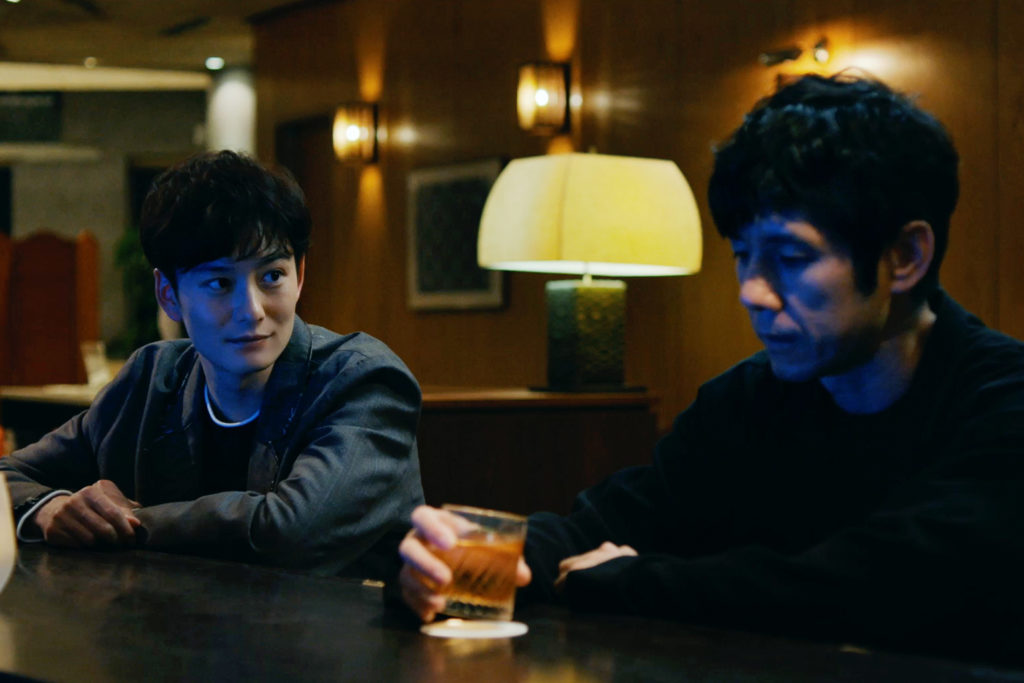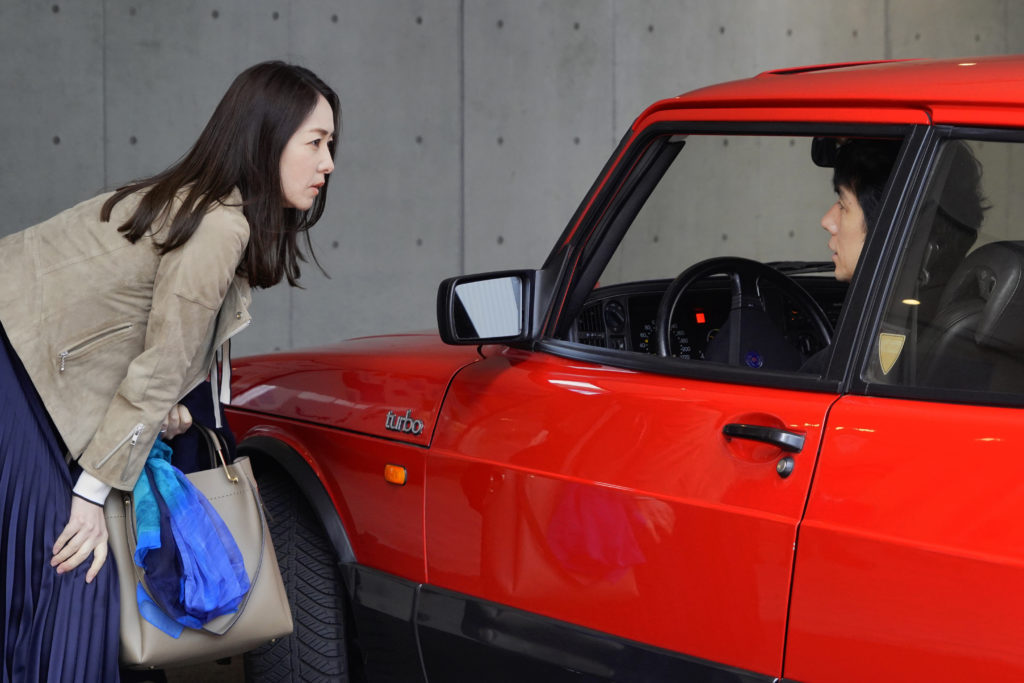Exploring the weight of its themes—sex and art, infidelity, grief—across a three-hour runtime, Ryusukue Hamaguchi’s Drive My Car is nothing less than a cinematic epic, adapted from a Haruki Murakami short story that encompasses a single conversation between two characters. Murakami’s story (which shares the same title) is one among several entries in the author’s 2014 collection Men Without Women, a series of stories interlinked by the theme of its title.
Given their disparity in length, it is somewhat surprising just how much Hamaguchi’s film retains the essence of Murakami’s original story. Even more surprising is the male protagonist—audiences outside Japan know Hamaguchi as a filmmaker of female-driven movies. His international breakthrough, Happy Hour (2015), a trilogy of films focusing on the lives of a group of women in contemporary Japan, is hardly concerned with the perspectives of its male characters; the men remain marginal throughout its combined 317-minute running time. His follow-up, Asako I and II, based on a novel about a woman who falls in love with a man who is a doppelgänger for a former flame, is similarly grounded in this female perspective.
Hamaguchi’s other most recent film, Wheel of Fortune and Fantasy (2021), is an omnibus film featuring a triptych of short narratives—all from a female point of view—loosely connected by an overarching theme of urban loneliness and romantic nostalgia. The film’s structure—and its melancholic atmosphere—is not dissimilar to the experience of reading a short story collection by Murakami. In that regard, Wheel of Fortune and Fantasy recalls Kelly Reichardt’s 2016 Certain Women (itself based on a series of short stories by Maile Meloy); they are both structurally linked to a literary style not often explored in cinema.
Hamaguchi’s approach here is much like that of Pedro Almodóvar’s with Julieta (2016), his adaptation of Alice Munro’s short story collection Runaway. They both undertake an adaptation of an individual short story by infusing it with elements from adjoining stories in their respective collections. This allows thematic links between the stories in the book.
It’s easy to see how Murakami’s original story appealed to Hamaguchi. It unfolds entirely through conversations between an aging male actor, Yusuke Kafuku (Hidetoshi Nishijima) and his young female chauffeur, Misaki (Toko Miura), while she ferries him in his Saab. Hamaguchi’s cinema is dialogue-driven, with lengthy conversations that tend to reveal their true meaning slowly. The dialogue meanders, diverges into tangents, and just when you think a scene has lost focus does its purpose in the narrative emerge. Like Ingmar Bergman’s cinema, it demands patience of viewers and is therefore rarely imitated. Hamaguchi regularly sets his conversations inside cars, an intimate and private setting, where real-life conversations frequently occur but are rarely depicted.
Hamaguchi says that Murakami’s story on its own was not robust enough for a feature film, but he knew it could serve as a launching point for the film he wanted to make. He drew from other short stories in Men Without Women to inform and expand his film adaptation. “It is, after all, a very short story—in Japanese it’s only 50 pages long—and I knew from the beginning that it was not going to be enough material,” he says. “When I was thinking about how I could expand it, I remembered Murakami wrote a preface in the short story collection, which is unusual for him, where he says that the short stories within the collection share similar themes. I knew, because I was working with Murakami’s work, that I couldn’t just selfishly expand it in ways that I wanted; I needed some kind of reason behind it. That’s how I started to use some things in the other short stories within the collection. That is how I came upon other stories in his book, like Scheherazade and Kino.”
The film’s lengthy prologue occupies its first 45 minutes and precedes the opening credits. It provides the backstory to Murakami’s source story and culminates when the film’s protagonist, Yusuke, discovers that his wife, Oto (Reika Kirishima), is having an affair with a younger actor, Kôji Takatsuki (Masaki Okada). Before Yusuke can confront her, she dies suddenly from a cerebral hemorrhage.
The film then picks up years later, in Hiroshima, where the actor-director has traveled to produce a multilingual adaptation of Anton Chekov’s Uncle Vanya. Yusuke assembles an international cast, asking them to perform their roles in their respective languages. The rest of the film revolves around this production, and the characters begin to discover interior truths about themselves and each other through Chekov’s themselves and each other through Chekov’s play.
“In Scheherazade, there is a character of a woman who starts storytelling after having sex. I incorporated that into Yusuke’s wife’s character,” Hamaguchi says. “What I found to be interesting about this point is that the act of sex and storytelling are connected in that story, which then becomes proof of having had sex. I thought it would give a very interesting effect to [Kôji and Yusuke’s] conversations, because it would reveal aspects of the infidelity in their shared past.
“There is a bar in Drive My Car, which is the same setting in Kino, so there was already a direct connection between the two stories. It was natural for me to think that these two stories would connect very well. Emotionally, the place where Yusuke finds himself at the end of my film is similar to where Kino ends up in Murakami’s story,” says Hamaguchi. “The other thing that I also incorporated from Kino is the sense of violence. In that story there is a big fight in a bar and a sense of foreboding violence that was interesting to bring into my version of Kôji’s character, who is a much nicer character in Murakami’s story.

“I’m able to speak about incorporating these elements only because you’re asking about them,” admits Hamaguchi. “As I reflect upon it, my process was to read these stories many times over and over before I started to write the screenplay. Once I began writing, the elements that I wound up incorporating appeared naturally to me, likely because Murakami has a world that is quite uniquely his and very built-up. When I was writing the script, I found myself writing something that I usually wouldn’t find myself writing—and that really speaks to the power of Murakami’s work.”
Hamaguchi’s Drive My Car isn’t merely interested in engaging with Murakami; the film also has a running dialogue with Anton Chekov’s Uncle Vanya. In that regard, it is an example of cinematic intertextuality, like Jean-Luc Godard’s Contempt (1963), which contains plot elements of Homer’s Odyssey. Both films explore themes of communication and miscommunication between couples set amid a multilingual adaptation of a classic work of fiction. Godard’s Contempt sends its screenwriter protagonist to Capri to rework the script for a film adaptation of The Odyssey. There, he and his wife struggle with mutual jealousy while navigating the French, English, German, and Italian spoken on the film set. The protagonists of Contempt and Drive My Car grapple with their partners’ infidelities and the end of their marriages—they are men without women.
Drive My Car parallels Uncle Vanya in the way it draws comparisons between the characters’ lives and the play they’re producing. Hamaguchi had previously referenced Chekov in a brief but memorable scene in Asako I and II. “Asako I and II engages with [Chekov’s] Three Sisters within the story,” he says. “Around that time, I’d started reading a lot of Chekov. I’ve always been interested in his work; I’ve found everything I’ve read of his really interesting. When Drive My Car came along, I saw that Uncle Vanya was mentioned in the original story. To be honest, I felt a calling and connection with the story when I found that. It also gave me the confidence to boldly use Uncle Vanya in the adaptation.
“Once it was decided that we were going to have Uncle Vanya in Drive my Car, I went back to reread the play. I was struck by what was being said in Uncle Vanya and the connection it has to the internal lives of the characters in the film. A lot of the dialogue [in the play] has people saying things that they usually wouldn’t say in real life, that they might be too embarrassed to say because it’s so revealing about their inner selves.”
That element plays directly into Hamaguchi’s thematic concerns, with characters communicating with each other by proxy through their production of Uncle Vanya, even as they cannot understand what the others are saying, with each role being performed in a different language. There, again, Drive My Car shares a close bond with Godard’s Contempt.
“I really love Contempt,” Hamaguchi says. “I watched it in my 20s and that film is probably deep inside me. Having said that, when I was making Drive My Car, I wasn’t necessarily thinking of that film in particular. Whenever I’m making a film myself, I’m not necessarily thinking in these abstract terms of communication or miscommunication per se. Usually, my films begin with me starting to write about characters who are having conversations, characters talking to each other, and as I’m writing, I realize the drama doesn’t move along sometimes because these characters can or can’t say certain things—and because of that they’re unable to move forward.”
Drive My Car, which exists at the intersection of literature, theater, and cinema, is Ryusuke Hamaguchi’s most ambitious film yet. Like the Murakami and Chekov works that inspire it, it is a complex and intricately layered masterwork that will reward those willing to devote their time to it.

At the Movies: Ryusuke Hamaguchi on the Importance of the Cinema Experience
“First and foremost, I am a film fan myself, so personally I feel like I understand the value of the theatrical experience to watch a movie in a cinema. What I learned under this pandemic is that this isn’t just my own experience; others understand this value as well. I was part of this campaign called Mini-Theater Aid, a crowdfunding campaign for small art house movie theaters in Japan. It was very successful in helping a lot of the art house theaters that were having financial trouble under the pandemic. With that crowdfunding campaign, we were able to raise about $30,000 for each participating theater. That was when I realized that a lot of people, in fact, think that the experience of a movie theater is of superior quality; it’s just a better way to watch movies. I also learned about how life-changing theatrical experiences can be, how much it supports a lot of people’s lives. And that really only comes out of the theatrical experience. Watching movies in a theater allows for more concentration, and there are movies where you could only understand their value if you’re watching it in a theater. The pandemic helped me realize how integrally tied the audience experience is with the theatrical experience.”
The post Ryusuke Hamaguchi on Adapting Haruki Murakami’s <em>Drive My Car</em> appeared first on Boxoffice.
from Boxoffice





0 comments:
Post a Comment